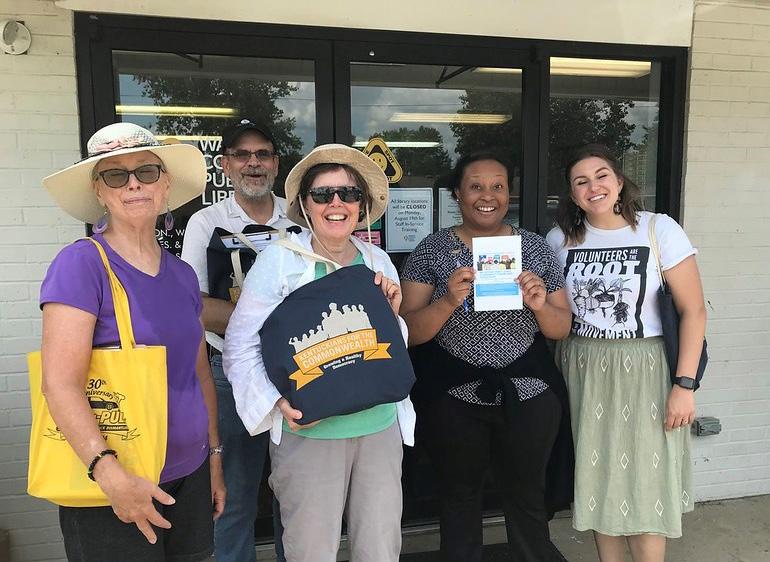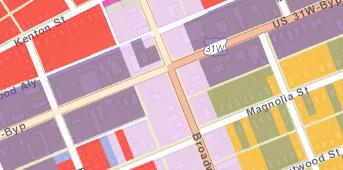
7 minute read
SECTION 5: IMPLEMENTATION OF PLANS Three broad methods of implementation An implementation strategy used in Bowling Green
REZONING PROCESS If a project requires a change in zoning, the applicant must get the zoning approved prior to going through the comprehensive development review process. Rezonings require approval from the legislative body and must go through the Planning Commission. The Planning Commission makes a recommendation to the legislative body after reviewing the rezoning application. Here is a summary of the typical rezoning process:
1
Advertisement
The applicant contacts the planning commission, which schedules a pre-application meeting. The applicant explains the proposed project, including the proposed use, density/ intensity, general layout and other related items such as proposed number of units/lots or proposed square footage for non-residential projects. The final application submission may look different or have different uses than what is initially discussed at the pre-application level due to ongoing discussions and input about the proposed project.
2
The applicant submits a formal application to the planning commission. Once the application is filed, the application and associated items become public record. Any application must include a general development plan or concept plan and development plan conditions that reflect the desired development along with a written detailed explanation addressing items as to how the proposed rezoning would adhere to the comprehensive plan.
3
The planning commission staff review the application to determine that it is a complete application and contains all items that are required. Staff also draft a report to be presented to the planning commission that contains information including comments from sister agencies, such as transportation agencies, utilities, and fire departments, that are affected by the proposed development. Staff publishes a preliminary agenda for the public hearing to the CCPC website with a notice on social media.
4
Public notice is posted in the newspaper, mailed to adjacent property owners, and posted on the property 14 days prior to the public hearing. Staff also mails letters to all residents within 200 feet of the proposed rezoning boundary.
5
Planning staff compiles any comments regarding the proposed zoning change and emails them to the applicants who have one week to make any revisions prior to the meeting materials being sent to commissioners.
6
Planning commission staff send planning commissioners the meeting materials for their review one week before the public hearing. The staff report is also posted on the planning commission website.
7
Public hearing is held about 30 days after the application is filed. During the public hearing, staff presents a report to the planning commission board explaining the location of the proposed amendment, proposed use of the property, any Development Plan Conditions the applicants have submitted, and other general information. Planning Commissioners consider the information contained in the staff report, the application and testimony provided by the applicant, and testimony by any member of the public including neighboring property owners.
9
Final approval is with the legislative body, City Commission, in the form of an ordinance which takes two readings. The City Commission considers the public record generated at the Planning Commission, along with the recommendation, and can either agree or disagree with the Planning Commission’s recommendation. The City Commission may not allow new testimony, nor allow any party to speak that was not present at the Planning Commission hearing unless a whole new hearing is scheduled. The City Commission typically affirms the Planning Commission recommendation the majority of the time.
10
If any person feels aggrieved by the process or decision made by the legislative body, that decision may be appealed to the Warren Circuit Court within 30 days from the final action (2nd reading) by the City Commission.
8
The planning commissioners forward their recommendation of approval or recommendation of denial to the appropriate legislative body, along with the minutes, staff report, and any other evidence submitted.
SECTION 5: IMPLEMENTATION OF PLANS
There are three broad methods for implementing plans. Development Regulations are controls, like zoning, that are guided by the comprehensive plan and placed on the use of land. Development review processes are in place to enforce development regulations. Examples of development regulations other than zoning: • Adequate Public Facilities Regulations: these regulations work to locate development where there are enough existing public services to support the development or dictate what the developer will provide in the way of public services like water and sewer infrastructure. Bowling Green’s adequate public facilities standards are in Section 6.3 in the Subdivision Regulations on the City-County Planning
Commission website. • Development Impact Fees: these are fees imposed on developers to cover the cost of their impact on public services and the community. The fees can be for things like roads, pipes, and wires, but sometimes cities will require them for other impacts. One example is a housing linkage fee, which is a fee that pays for new affordable housing resulting from new commercial development. The idea is that if you are bringing 50 minimum wage jobs to an area, you need to pay for the impact on the increasing demand of affordable housing.
Note: Development Impact Fees are currently illegal in the state of Kentucky. Zoning reform can help make progress towards comprehensive plan goals. Minneapolis ended single family zoning and allowed at least three-unit homes in all residential zones to help address the following elements from the Minneapolis 2040 Plan. • Housing Affordability • Economic and Racial Segregation • Climate Change

Capital Improvements are often infrastructure projects of high priority such as streets, utilities, parks, and public buildings. The capital improvement program (CIP) is under the purview of the city of Bowling Green, not the Planning Commission. Planning Commission receives a copy of the approved CIP but is not involved in its creation or implementation. You can view reports on Bowling Green’s capital improvement expenditures here: https://www.bgky.org/reports/capital-improvements-program
Programs can be official city or county programs such as policies that incentivize developers to provide a number of affordable units in their projects. Programs can include additional plans and studies, like neighborhood planning programs. Operational changes within the city and volunteer and community programs like conservation groups and farmers markets can also help meet comprehensive planning goals.
AN IMPLEMENTATION STRATEGY USED IN BOWLING GREEN
Tax Increment Financing (TIF) Districts TIF is a financing method that involves increasing property values. In simplest terms, a municipality determines a development area and invests a certain amount of money into that area for development projects. This investment often involves the municipality securing bonds, which have to be paid back. This investment sparks additional private investment in the development area. The development projects are considered to be improvements and result in an increase in property values in the area. Since property taxes are calculated based on property values, an increase in property values results in an increase in property taxes. The increase in property taxes is called a tax increment.
property taxes after improvements - property taxes before improvements = tax increment
The municipality receives the original property tax amount before improvements and the extra taxes (the tax increment) go toward paying off the original investment/bonds. Once all debt from the TIF district is paid off, the TIF district ceases and all additional tax dollars go to the municipality. How TIF Works: A Simplified Example

Bowling Green TIF District: WKU Gateway Bowling Green has one of the state’s largest TIF districts. Its boundaries can be seen below. Kentucky has two different TIF programs that involve state participation. One of those is the Signature Program, which is the program used for the WKU Gateway. State participation means that state taxes can be collected and returned to pay for the projects within the TIF district. Bowling Green took out $25 million in General Obligation bonds for the Hot Rods ballpark and used a hotel tax to fund SKyPAC to reach the investment threshold needed to be eligible for the Signature TIF program. Taxes being recovered and put towards the payment of the bonds are individual income tax, property tax, sales tax, and withholding tax. The Warren County Downtown Economic Development Authority is the governing body for the district, not Planning Commission.

ADDITIONAL ONLINE RESOURCES
Planning tinyurl.com/whatisurbanplanning tinyurl.com/historyofplanning
Zoning tinyurl.com/Zoning-Codes tinyurl.com/Zoning101Regina tinyurl.com/Zoning101Phoenix
Navigating the City-County Planning Commission Maps tinyurl.com/usingthemap1 tinyurl.com/usingthemap2









